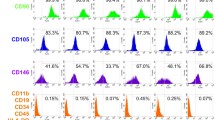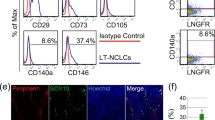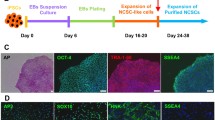Abstract
Cell therapy for peripheral nerve injury is a promising strategy as regenerative medicine that restores neurological function. However, challenges remain in producing suitable and sufficient amounts of autologous cells for promoting nerve regeneration. This study aimed to identify the characteristics of neural lineage cells (NLCs) differentiated from dental pulp stem cells (DPSCs) and reveal their effect on functional recovery and nerve regeneration after cell transplantation into an immunodeficient rat using a nerve guide conduit. Here we report a protocol of neural induction in monolayer culture and characterize NLCs in vitro. Furthermore, NLCs were transplanted into an immunodeficient rat model with a 10-mm sciatic nerve defect, and cell survival and differentiation were investigated in vivo. Outcomes of nerve regeneration were also assessed using the remyelinated axon numbers, myelin sheath thickness, electrophysiological activities, and gastrocnemius muscle mass. NLCs comprised neuronal, astrocyte, oligodendrocyte, and neural crest lineage cells. NLCs enhanced the activities of endothelial cells, Schwann cells, and neurons in a paracrine-dependent manner in vitro. At 2 weeks post-transplantation, numerous transplanted NLCs differentiated into platelet-derived growth factor receptor alpha (PDGFRα) + oligodendrocyte progenitor cells (OPCs) and a few PDGFRα + /p75 neurotrophin receptor + Schwann cell-like cells derived from OPCs were observed. At 12 weeks post-transplantation, human Schwann cell-like cells survived, and axon growth, remyelination, electrophysiological activities, and muscle atrophy were improved. This study demonstrates the broad application of our protocol of neural induction of DPSCs and portrays the efficacy of transplantation of NLCs derived from human DPSCs as a promising strategy for peripheral nerve regeneration.






Similar content being viewed by others
References
Wang C, Lu CF, Peng J, Hu CD, Wang Y. Roles of neural stem cells in repair of peripheral nerve injury. Neural Regen Res. 2017;12(12):2106–12.
Nocera G, Jacob C. Mechanisms of Schwann cell plasticity involved in peripheral nerve repair after injury. Cell Mol Life Sci. 2020;77(20):3977–89.
Kim S, Lee J, Lee DY, et al. Schwann cell precursors from human pluripotent stem cells as a potential therapeutic target for myelin repair. Stem Cell Rep. 2017;8(6):1714–26.
Murakami T, Fujimoto Y, Yasunaga Y, et al. Transplanted neuronal progenitor cells in a peripheral nerve gap promote nerve repair. Brain Res. 2003;974(1–2):17–24.
Mothe AJ, Tator CH. Review of transplantation of neural stem/progenitor cells for spinal cord injury. Int J Dev Neurosci. 2013;31(7):701–13.
Lee ST, Chu K, Park HK, et al. New concept of neural stem cell transplantation: anti-inflammatory role. Int J Stem Cells. 2008;1(1):36–42.
Yang H, Wang C, Chen H, et al. Neural stem cell-conditioned medium ameliorated cerebral ischemia-reperfusion injury in rats. Stem Cells Int. 2018;4659159.
Sareen D, Gowing G, Sahabian A, et al. Human induced pluripotent stem cells are a novel source of neural progenitor cells (iNPCs) that migrate and integrate in the rodent spinal cord. J Comp Neurol. 2014;522(12):2707–28.
Reubinoff BE, Itsykson P, Turetsky T, et al. Neural progenitors from human embryonic stem cells. Nat Biotechnol. 2001;19(12):1134–40.
Zhang SC, Wernig M, Duncan ID, Brüstle O, Thomson JA. In vitro differentiation of transplantable neural precursors from human embryonic stem cells. Nat Biotechnol. 2001;19(12):1129–33.
Takahashi H, Ishikawa H, Tanaka A. Regenerative medicine for Parkinson’s disease using differentiated nerve cells derived from human buccal fat stem cells’. Hum Cell. 2017;2:60–71.
Fu L, Zhu L, Huang Y, Lee TD, Forman SJ, Shin CC. Derivation of neural stem cells from mesenchymal stem cells: evidence for a bipotential stem cell population. Stem Cells Dev. 2008;17(6):1109–21.
Peng C, Lu L, Li Y, Hu J. Neurospheres induced from human adipo-derived stem cells as a new source of neural progenitor cells. Cell Transpl. 2019;28(1):66S-75S.
Gao S, Guo X, Zhao S, et al. Differentiation of human adipose-derived stem cells into neuron/motoneuron-like cells for cell replacement therapy of spinal cord injury. Cell Death Dis. 2019;10:597.
Chang CC, Chang KC, Tsai SJ, Chang HH, Lin CP. Neurogenic differentiation of dental pulp stem cells to neuron-like cells in dopaminergic and motor neuronal inductive media. J Formos Med Assoc. 2014;113(12):956–65.
Kogo Y, Seto C, Totani Y, et al. Rapid differentiation of human dental pulp stem cells to neuron-like cells by high K+ stimulation. Biophys Physicobiol. 2020;17:132–9.
Chai Y, Jiang XJ, Ito Y, et al. Fate of the mammalian cranial neural crest during tooth and mandibular morphogenesis. Development. 2000;127(8):1671–9.
Sakai K, Yamamoto A, Matsubara K, et al. Human dental pulp-derived stem cells promote locomotor recovery after complete transection of rat spinal cord by multiple neuro-regenerative mechanisms. J Clin Invest. 2011;122(1):80–90.
Fernandes TG, Duarte ST, Ghazvini M, et al. Neural commitment of human pluripotent stem cells under defined conditions recapitulates neural development and generates patient-specific neural cells. Biotechnol J. 2015;10(10):1578–88.
Sloan SA, Darmanis S, Huber N, et al. Human astrocyte maturation captured in 3D cerebral cortical spheroids derived from pluripotent stem sell. Neuron. 2017;95(4):779–90.
Galiakberova AA, Dashinimaev EB. Neural stem cells and methods for their generation from induced pluripotent stem cells in vitro. Front Cell Dev Biol. 2020;8:815.
Meijer M, Rehbach K, Brunner JW, et al. A single-cell model for synaptic transmission and plasticity in human iPSC-derived neurons. Cell Rep. 2019;27(7):2199-2211.e6.
Marrelli M, Paduano F, Tatullo M. Human periapical cyst-mesenchymal stem cells differentiate into neuronal cells. J Dent Res. 2015;94(6):843–52.
Jelitai M, Anderová M, Chvátal A, Madarász E. Electrophysiological characterization of neural stem/progenitor cells during in vitro differentiation: study with an immortalized neuroectodermal cell line. J Neurosci Res. 2007;85(8):1606–17.
Assinck P, Duncan GJ, Plemel JR, et al. Myelinogenic plasticity of oligodendrocyte precursor cells following spinal cord contusion injury. J Neurosci. 2017;37(36):8635–54.
Bartus K, Burnside ER, Galino J, et al. Erbb receptor signaling directly controls oligodendrocyte progenitor cell transformation and spontaneous remyelination after spinal cord injury. Glia. 2019;67(6):1036–46.
Kegler K, Spitzbarth I, Imbschweiler I, Wewetzer K, Baumgärtner W, Seehusen F. Contribution of schwann cells to remyelination in a naturally occurring canine model of CNS neuroinflammation. PLoS ONE. 2015;10(7):e0133916.
Imbschweiler I, Seehusen F, Peck CT, Omar M, Baumgärtner W, Wewetzer K. Increased p75 Neurotrophin receptor expression in the canine distemper virus model of multiple sclerosis identifies aldynoglial schwann cells that emerge in response to axonal damage. Glia. 2012;60(3):358–71.
Mi R, Shinn D, Li Y, et al. Oligodendrocyte precursors gain schwann cell-like phenotype and remyelinate axons upon engraftment into peripheral nerves. J Tissue Eng Regen Med. 2019;13(10):1854–60.
Maed B, Logan A, Berry M, Leadbeater W, Scheven BA. Paracrine-mediated neuroprotection and neuritogenesis of axotomised retinal ganglion cells by human dental pulp stem cells: comparison with human bone marrow and adipose-derived mesenchymal stem cells. PLoS ONE. 2014;9(10):e109305.
Sultan N, Amin LE, Zaher AR, Scheven BA, Grawish M. Dental pulp stem cells: novel cell-based and cell-free therapy for peripheral nerve repair. World J Stomatol. 2019;7(1):1–19.
Wang DR, Wang YH, Pan J, Tian WD. Neurotrophic effects of dental pulp stem cells in repair of peripheral nerve after crush injury. World J Stem Cells. 2020;12(10):1196–213.
Martens W, Sanen K, Georgiou M, et al. Human dental pulp stem cells can differentiate into schwann cells and promote and guide neurite outgrowth in an aligned tissue-engineered collagen construct in vitro. FASEB J. 2014;28(4):1634–43.
Hei WH, Kim S, Park JC, et al. Schwann-like cells differentiated from human dental pulp stem cells combined with a pulsed electromagnetic field can improve peripheral nerve regeneration. Bioelectromagnetics. 2016;37(3):163–74.
Sanen K, Martens W, Georgiou M, Ameloot M, Lambrichts I, Phillips J. Engineered neural tissue with Schwann cell differentiated human dental pulp stem cells: potential for peripheral nerve repair? J Tissue Eng Regen Med. 2017;11(12):3362–72.
Carnevale G, Pisciotta A, Riccio M, et al. Human dental pulp stem cells expressing STRO-1, c-kit and CD34 markers in peripheral nerve regeneration. J Tissue Eng Regen Med. 2018;12(2):e774–85.
Xia G, Ji P, Rutgeerts O, Waer M. Natural killer cell- and macrophage mediated discordant guinea pig–>rat xenograft rejection in the absence of complement, xenoantibody and T cell immunity. Transplantation. 2000;70(1):86–93.
Wang A, Tang Z, Park IH, et al. Induced pluripotent stem cells for neural tissue engineering. Biomaterials. 2011;32(22):5023–32.
Ujita S, Sasaki T, Asada A, et al. cAMP-dependent calcium oscillations of astrocytes: an implication for pathology. Cereb Cortex. 2017;27(2):1602–14.
Acknowledgements
We thank Dr. Toshiaki Tachibana (Division of Fine Morphology, Core Research Facilities, Jikei University School of Medicine) for guidance with electron microscopy.
Funding
The authors disclose receipt of the following financial support for the research, authorship, and/or publication of this article: this work was supported by Grants-in-Aid for Scientific Research from the Ministry of Education, Culture, Sports, Science and Technology, Japan (Grant Numbers 16K15817, 19K09450, and 20H03761) and Translational Research Program (University of Tsukuba, A18-36) for the Japan Agency for Medical Research and Development.
Author information
Authors and Affiliations
Contributions
ST: Contributed to the study conception and design, data acquisition and analysis, and drafting of the manuscript. FU: Contributed to the study conception and design, data analysis, and drafting of the manuscript. HI and HB: Contributed to the study conception and design, data analysis and interpretation, and drafting and critical revision of the manuscript. JT, AO, MW, HM, and SI: Contributed to data acquisition, analysis, interpretation, and drafting of the manuscript. AM, TY, and YM: Contributed to data interpretation and critical revision of the manuscript. NIK, SF, and KY: Contributed to data analysis and interpretation, and critical revision of the manuscript. All authors approved the final version of the manuscript and agree to be accountable for all aspects of this work.
Corresponding author
Ethics declarations
Conflict of interest
The authors declare no potential conflicts of interest with respect to the authorship and/or publication of this article.
Ethics approval
This study was performed in accordance with the guidelines of the research ethics committee of the University of Tsukuba (Approval No. H29-173). Animal experiments were performed in a humane manner after receiving approval from the Institutional Animal Care and Use Committee of the University of Tsukuba (Approval No. 20-232).
Informed consent
Informed consent was obtained from all subjects.
Additional information
Publisher's Note
Springer Nature remains neutral with regard to jurisdictional claims in published maps and institutional affiliations.
Supplementary Information
Below is the link to the electronic supplementary material.
13577_2021_634_MOESM2_ESM.docx
Supplementary file2 (DOCX 391 kb) Characterization of NLCs. (a) NLCs were immunostained with antibodies against STEM123 (human GFAP) and DCX. Coexpression of GFAP and DCX is indicated by white arrows. Scale bar = 50 µm (b) An ELISA was used to determine the VEGF levels in CM from DPSCs and NLCs (n = 3/group). *p < 0.01. (c) Three clusters were correlated with the maturation of GFAP+ cells. The gene expression profiles of NLCs were adapted. Cluster 1, early pseudo-time; cluster 2, middle pseudo-time; cluster 3, late pseudo-time
Supplementary file3 (AVI 2584 kb). Neuronal activities of NLCs using calcium indicators at 50 DIV
Rights and permissions
About this article
Cite this article
Takaoka, S., Uchida, F., Ishikawa, H. et al. Transplanted neural lineage cells derived from dental pulp stem cells promote peripheral nerve regeneration. Human Cell 35, 462–471 (2022). https://doi.org/10.1007/s13577-021-00634-9
Received:
Accepted:
Published:
Issue Date:
DOI: https://doi.org/10.1007/s13577-021-00634-9




